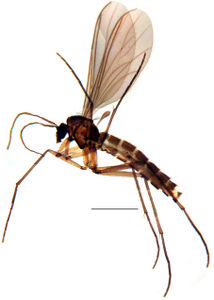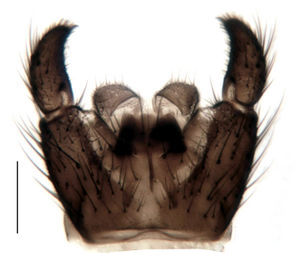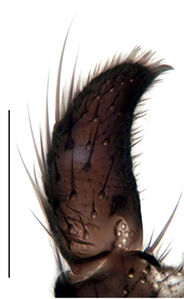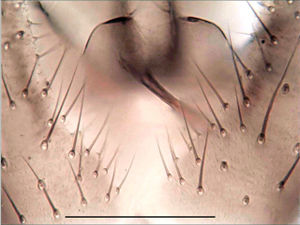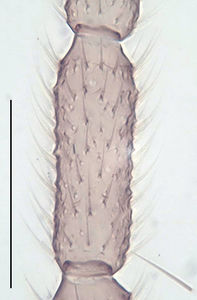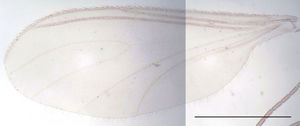Difference between revisions of "Trichosiopsis juniperi"
Kai Heller (Talk | contribs) |
Kai Heller (Talk | contribs) |
||
| (3 intermediate revisions by the same user not shown) | |||
| Line 1: | Line 1: | ||
| + | {{TOC|right}} | ||
{{Treatment start | {{Treatment start | ||
| Ordo = Diptera | | Ordo = Diptera | ||
| Familia = Sciaridae | | Familia = Sciaridae | ||
| − | | Genus = | + | | Genus = Trichosiopsis |
| Specific name = juniperi | | Specific name = juniperi | ||
| Infraspecific name = | | Infraspecific name = | ||
| Line 10: | Line 11: | ||
| Nomenclature citation = {{Nomenclature citation |''Trichosia (Leptosciarella) juniperi'' {{aut|Mohrig & Blasco-Zumeta}}, 1996<ref name=SC223>{{aut|Mohrig, W.; Blasco-Zumeta, J.}} 1996: The sciarid fauna (Diptera, Sciaridae) of a <i>Juniperus thurifera</i> L. forest of the Monegros region (Zaragoza, Spain) with description of ten new species. ''Miscellania Zoologica (Barcelona)'', '''18''', 99–116.</ref>: 103}} | | Nomenclature citation = {{Nomenclature citation |''Trichosia (Leptosciarella) juniperi'' {{aut|Mohrig & Blasco-Zumeta}}, 1996<ref name=SC223>{{aut|Mohrig, W.; Blasco-Zumeta, J.}} 1996: The sciarid fauna (Diptera, Sciaridae) of a <i>Juniperus thurifera</i> L. forest of the Monegros region (Zaragoza, Spain) with description of ten new species. ''Miscellania Zoologica (Barcelona)'', '''18''', 99–116.</ref>: 103}} | ||
| Wikispecies page name = Leptosciarella_juniperi | | Wikispecies page name = Leptosciarella_juniperi | ||
| − | | ZooBank ID = | + | | ZooBank ID =urn:lsid:zoobank.org:act:824E42A0-7E38-4550-A8D7-F0649B1A1B5A |
}} | }} | ||
| Line 27: | Line 28: | ||
==Diagnosis and discussion== | ==Diagnosis and discussion== | ||
| − | '' | + | ''Trichosiopsis juniperi'' belongs to the ''Leptosciarella pilosa'' species-complex by its slender and non angulate gonostyli. These are still more tapered than in ''[[Trichosiopsis pilosa]]'' and ''[[Trichosiopsis subspinulosa]]'', which share the dark abdominal setae. All other species of this complex have at least partially brightened abdominal setae. Specimens of ''[[Trichosiopsis ignis]]'' were often identified as ''Tr. juniperi''. Boths species share the tapered gonostyli, which in ''Tr. juniperi'' are still more slender and do not have the awl-like setae not reaching so far down mesially. |
| + | Mohrig & Menzel 1997: 75<ref name="SC226">{{aut|Mohrig, W.; Menzel, F.}} 1997: Revision der paläarktischen Arten von ''Trichosia'' Winnertz sensu Tuomikoski, 1960 (Diptera, Sciaridae). – Teil II. Gattungen ''Leptosciarella'' Tuomikoski, 1960 und ''Trichodapus'' gen. nov. ''Studia dipterologica'', '''4'''(1), 41–98.</ref> discuss a possible identity of this species with ''[[Trichosiopsis longistilis]]'' (Hondru, 1968). Indeed the description and drawings presented by Hondru<ref name="SC110">{{aut|Hondru, N.}} 1968: Neue Sciaridae-Arten (Diptera - Nematocera). ''Revue roumaine de biologie (Série de Zoologie)'', '''13'''(2), 87–97.</ref> are according quite well with ''Tr. juniperi''. Even the dorsally elongated awl-like setae, which brought Hondru to compare his species with ''[[Leptospina atricha]]'', are also distinctive in ''Tr. juniperi''. But the wing length is given as only 1.65 mm and thus much shorter. A comparison with the type material (if still available) or with newly collected specimens from Romania is necessary to clarify this issue. | ||
==Etymology== | ==Etymology== | ||
| Line 40: | Line 42: | ||
Spain Canary Islands<ref name="SC232">{{aut|Menzel, F.; Mohrig, W.; Báez, M.}} 1997: Die Trauermücken-Fauna der Kanarischen Inseln, unter Berücksichtigung der von Richard Frey beschriebenen Arten (Insecta: Diptera, Sciaridae). ''Vieraea'', '''25''', 133–146.</ref>. | Spain Canary Islands<ref name="SC232">{{aut|Menzel, F.; Mohrig, W.; Báez, M.}} 1997: Die Trauermücken-Fauna der Kanarischen Inseln, unter Berücksichtigung der von Richard Frey beschriebenen Arten (Insecta: Diptera, Sciaridae). ''Vieraea'', '''25''', 133–146.</ref>. | ||
| − | '''Remark:''' The records in [http://www.faunaeur.org/full_results.php?id=404445|''Fauna Europaea''] from Austria<ref name="SC226" />, Czech Republic<ref name="SC226" />, Finland<ref name="SC542">{{aut|Vilkamaa, P.; Salmela, J.; Hippa, H.}} 2007: Black fungus-gnats in deciduous forest habitat in northern Europe, with the description of ''Bradysia arcula'' sp. n. (Diptera: Sciaridae). ''Entomologica Fennica'', '''18'''(4), 226-231.</ref>, Germany and Turkmenistan<ref name="SC226" /> | + | '''Remark:''' The records in [http://www.faunaeur.org/full_results.php?id=404445|''Fauna Europaea''] from Austria<ref name="SC226" />, Czech Republic<ref name="SC226" />, Finland<ref name="SC542">{{aut|Vilkamaa, P.; Salmela, J.; Hippa, H.}} 2007: Black fungus-gnats in deciduous forest habitat in northern Europe, with the description of ''Bradysia arcula'' sp. n. (Diptera: Sciaridae). ''Entomologica Fennica'', '''18'''(4), 226-231.</ref>, belong to ''Tr. ignis'', those from Germany to ''Tr. yerburyi'' and from Turkmenistan<ref name="SC226" /> to ''Tr. pilosa''. ''Tr. juniperi'' therefore seems to have a strictly Mediterranean distribution. |
==Images== | ==Images== | ||
| + | |||
{{Gallery | lines=3 | width=300 | {{Gallery | lines=3 | width=300 | ||
| − | |1= File:Leptosciarella juniperi KH6782 Gonostylus.jpg|2= '''Figure 1.''' '' | + | |
| − | |3= File:Leptosciarella juniperi KH6782 Hypopygium.jpg|4= '''Figure 2.''' '' | + | |1= File:Leptosciarella juniperi KH6782 Gonostylus.jpg|2= '''Figure 1.''' ''Trichosiopsis juniperi'' male, gonostylus, scale 0.1 mm |
| − | |5= File:Leptosciarella juniperi KH6782 Habitus.jpg|6= '''Figure 3.''' '' | + | |
| − | |7= File:Leptosciarella juniperi KH1482 Tegmen.jpg|8= '''Figure 4.''' '' | + | |3= File:Leptosciarella juniperi KH6782 Hypopygium.jpg|4= '''Figure 2.''' ''Trichosiopsis juniperi'' male, hypopygium, scale 0.1 mm |
| − | |9= File:Leptosciarella juniperi KH1482 Antenna.jpg|10= '''Figure 5.''' '' | + | |
| − | |11= File:Leptosciarella juniperi KH1482 Wing.jpg|12= '''Figure 6.''' '' | + | |5= File:Leptosciarella juniperi KH6782 Habitus.jpg|6= '''Figure 3.''' ''Trichosiopsis juniperi'' male, gonostylus, scale 0.1 mm |
| + | |||
| + | |7= File:Leptosciarella juniperi KH1482 Tegmen.jpg|8= '''Figure 4.''' ''Trichosiopsis juniperi'' male, aedeagal complex, scale 0.1 mm | ||
| + | |||
| + | |9= File:Leptosciarella juniperi KH1482 Antenna.jpg|10= '''Figure 5.''' ''Trichosiopsis juniperi'' male, 4<sup>th</sup> antennal flagellar segment, scale 0.1 mm | ||
| + | |||
| + | |11= File:Leptosciarella juniperi KH1482 Wing.jpg|12= '''Figure 6.''' ''Trichosiopsis juniperi'' male, wing, scale 1 mm | ||
| + | |||
}} | }} | ||
Latest revision as of 18:59, 1 January 2021
Ordo: Diptera
Familia: Sciaridae
Genus: Trichosiopsis
Name
Trichosiopsis juniperi (Mohrig & Blasco-Zumeta, 1996) – Wikispecies link – ZooBank link
- Trichosia (Leptosciarella) juniperi Mohrig & Blasco-Zumeta, 1996[1]: 103
Type material
Holotype ♂, in PWMP, leg. Blasco-Zumeta, 17.03.1990.
Type locality
Spain, Aragón, Retuerta de Pina, near Zaragoza
Additional material examined
Spain, Canary Islands: 1 ♂, La Palma, La Zarza, Barranco, 1050m, sweep netting, Heller, 30.03.1996, PKHH 1482; 1 ♂, La Gomera, Laguna Grande, laurel forest, yellow pan trap, Mohrig, 28.07.1993, PKHH 6874.
Description (male)
Head. Eye bridge 3 rows of facets. LW-index of 4th antennal flagellar segment 2.8–3.2; neck 0.37–0.45 of segment width; Transition of basal part to neck pronounced. Colour of neck unicolour. Antennal hairs shorter than segment width, or as long as segment width; salient. Palps bright, or darkened; normal; palpomeres 3. First palpomere thickened; with 4–6 bristles; with only some sparse sensillae. Second palpomere shortly oval. Third palpomere as long as first segment. Thorax. Colour brown. Notum unicolorous. Thoracic setae long and strong; dark, or darkened. Mesonotum with some weaker central bristles. Posterior pronotum setose. Postpronotal setae 1–2; fine. Laterotergite bare. Legs. Colour yellow, or yellow-brown. Hind coxae of same colour as femora. Hairs on fore coxae black. Frontal tibia with a patch of setae. Front tibial organ dark. Front tibial organ not bordered. Tibial setae on hind legs normal, shorter than tibial width, or very strong, as long or longer longer than tibial width. Tibial spurs of equal length. Claws untoothed. Wings. Wings slightly darkened; of normal shape. Wing membrane without macrotrichia. Wing venation weak, with faint m-base. M-fork of normal shape. R1 inserting at or slightly before base of m-fork; posterior veins with macrotrichia; stM mainly with macrotrichia; cuA1 and cuA2 mainly with macrotrichia; bM bare; r-m bare, or with a few setae; bM:r-M 0.7–0.9; st-Cu:bM 0.4–0.6; r1:r 1.6–2; C:w 0.68–0.79. Halteres dark; of normal length, or long. Abdomen. Abdominal setae strong and dense; dorsally dark; ventrally dark. Hypopygium concolour with abdomen; Length/Width 0.62–0.75 longer than wide. Base of gonocoxites with normal, weak hairs; gonocoxites broadly separated; inner margin of gonocoxites narrowly U-shaped; inner part of hypopygium bare, or scarcely setose; elongated setae on valves of hypopygium absent. Gonostylus elongate; 2.45–2.65 × longer than wide; Inner margin straight; apex tapered. Apical tooth present; 2–2.4 × longer than broad; strong. Awl-like setae normal; below apex present. Megasetae on inner part of gonostylus absent. Whiplash-hair missing. Tegmen 0.4–0.55 × longer than broad; rectangular with rounded edges; normal; Central process absent. Length of aedeagus/hypopygium 24–30 %; Aeadeagal apical structure absent. Measurements. Body size 2.8–3.2 mm. Wing length 2.5–3.2 mm.
Diagnosis and discussion
Trichosiopsis juniperi belongs to the Leptosciarella pilosa species-complex by its slender and non angulate gonostyli. These are still more tapered than in Trichosiopsis pilosa and Trichosiopsis subspinulosa, which share the dark abdominal setae. All other species of this complex have at least partially brightened abdominal setae. Specimens of Trichosiopsis ignis were often identified as Tr. juniperi. Boths species share the tapered gonostyli, which in Tr. juniperi are still more slender and do not have the awl-like setae not reaching so far down mesially. Mohrig & Menzel 1997: 75[2] discuss a possible identity of this species with Trichosiopsis longistilis (Hondru, 1968). Indeed the description and drawings presented by Hondru[3] are according quite well with Tr. juniperi. Even the dorsally elongated awl-like setae, which brought Hondru to compare his species with Leptospina atricha, are also distinctive in Tr. juniperi. But the wing length is given as only 1.65 mm and thus much shorter. A comparison with the type material (if still available) or with newly collected specimens from Romania is necessary to clarify this issue.
Etymology
The species name refers to the habitat of the type locality, a Juniperus thuriferus (Juniper) forest.
Ecology
The species occurs mainly in Mediterranean forests.
Distribution
? Italy[2], Spain[1], Spain Canary Islands[4].
Remark: The records in Fauna Europaea from Austria[2], Czech Republic[2], Finland[5], belong to Tr. ignis, those from Germany to Tr. yerburyi and from Turkmenistan[2] to Tr. pilosa. Tr. juniperi therefore seems to have a strictly Mediterranean distribution.
Images
|
References
- ↑ 1.0 1.1 Mohrig, W.; Blasco-Zumeta, J. 1996: The sciarid fauna (Diptera, Sciaridae) of a Juniperus thurifera L. forest of the Monegros region (Zaragoza, Spain) with description of ten new species. Miscellania Zoologica (Barcelona), 18, 99–116.
- ↑ 2.0 2.1 2.2 2.3 2.4 Mohrig, W.; Menzel, F. 1997: Revision der paläarktischen Arten von Trichosia Winnertz sensu Tuomikoski, 1960 (Diptera, Sciaridae). – Teil II. Gattungen Leptosciarella Tuomikoski, 1960 und Trichodapus gen. nov. Studia dipterologica, 4(1), 41–98.
- ↑ Hondru, N. 1968: Neue Sciaridae-Arten (Diptera - Nematocera). Revue roumaine de biologie (Série de Zoologie), 13(2), 87–97.
- ↑ Menzel, F.; Mohrig, W.; Báez, M. 1997: Die Trauermücken-Fauna der Kanarischen Inseln, unter Berücksichtigung der von Richard Frey beschriebenen Arten (Insecta: Diptera, Sciaridae). Vieraea, 25, 133–146.
- ↑ Vilkamaa, P.; Salmela, J.; Hippa, H. 2007: Black fungus-gnats in deciduous forest habitat in northern Europe, with the description of Bradysia arcula sp. n. (Diptera: Sciaridae). Entomologica Fennica, 18(4), 226-231.
